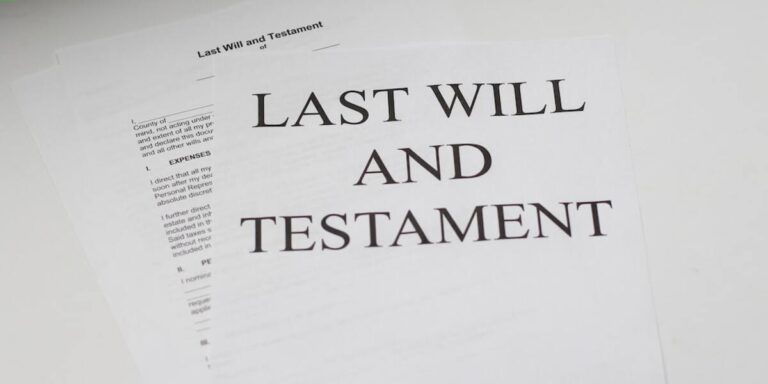Estate Planning For Disinheritance Strategies
If you find yourself questioning the future of your estate and how to navigate the complexities of disinheritance strategies, look no further. This article offers a comprehensive overview of estate planning and its intricacies, shedding light on the vital aspects of estate formation. Whether you seek to protect your assets, redefine beneficiaries, or ensure a smooth transfer of wealth, this guide will equip you with the information necessary to make informed decisions. Don’t hesitate to reach out to the experienced estate planning lawyer listed on the page for a consultation, as they can offer tailored advice and personalized solutions to your unique circumstances.
Estate Planning for Disinheritance Strategies

This image is property of images.unsplash.com.
Introduction
Estate planning is an essential component of responsible financial management. It involves making a comprehensive plan for the distribution of your assets and possessions after your demise. While most estate planning focuses on providing for the loved ones and family members, there are circumstances where you may consider disinheriting certain individuals. Disinheritance is a deliberate decision to exclude someone from inheriting any part of your estate. This article aims to shed light on the concept of disinheritance, the importance of estate planning for such strategies, and common scenarios where disinheriting may be considered.
Understanding Disinheritance
Disinheritance refers to the intentional act of excluding someone from receiving any inheritance or assets from your estate after your passing. There can be various reasons why individuals may consider disinheriting certain individuals, ranging from strained relationships to a lack of trust. Disinheritance is a legally recognized action, but it may vary in its implications depending on state laws and individual circumstances. It is important to navigate this process with caution and seek legal advice to ensure your wishes are carried out effectively and without any unintended consequences.
Importance of Estate Planning for Disinheritance Strategies
Planning your estate involves making important decisions about the distribution of your assets, and this includes considering disinheritance strategies if it aligns with your intentions. Without proper estate planning, the laws of intestacy will dictate how your estate is distributed, which may not align with your wishes. By including disinheritance strategies as part of your estate plan, you can ensure that your assets are distributed according to your preferences and prevent potential conflicts among beneficiaries.
Common Disinheritance Scenarios
Disinheritance can occur in various relationships, such as with children, spouses, other family members, non-family members such as friends and business partners, as well as charitable organizations. Each scenario presents unique considerations and potential legal implications. Let’s explore some common disinheritance scenarios and the factors to consider for each:

This image is property of images.unsplash.com.
1. Disinheriting a Child
1.1. Legal Implications
Disinheriting a child is a sensitive and emotionally charged decision. While each jurisdiction may have specific laws regarding disinheritance, it is essential to understand the potential legal implications involved. In some states, certain protections may be in place for children to ensure they receive a minimum share of the estate, regardless of disinheritance attempts. Seeking legal advice can help you navigate these legal complexities and ensure your wishes are carried out within the limits of the law.
1.2. Alternative Arrangements
Disinheritance should prompt consideration of alternative arrangements to ensure a child’s well-being. While you may choose not to leave them any inheritance, it is important to determine whether other provisions need to be made for their care, such as life insurance policies, educational trusts, or setting up a trust to provide for their needs indirectly. Exploring these alternative arrangements can help mitigate any potential negative consequences of disinheritance.
1.3. Communicating With the Child
When it comes to disinheriting a child, communication is crucial. It is important to express your intentions clearly and explain the reasons behind the decision. While this can be a difficult conversation, it can help prevent misunderstandings and potential legal disputes down the line. It is wise to approach the conversation with empathy and sensitivity, allowing them to express their feelings and concerns.
2. Disinheriting a Spouse
2.1. Legal Considerations
Disinheriting a spouse also requires careful consideration of legal implications. Spousal rights vary depending on the jurisdiction and marital status. In some cases, a spouse may have a legal right to claim a portion of the estate, even if disinherited, especially in the absence of a prenuptial or postnuptial agreement. Understanding the legal considerations surrounding spousal rights is crucial in crafting an effective estate plan that aligns with your intentions.
2.2. Pre/Postnuptial Agreements
One way to ensure your wishes regarding spousal inheritance are respected is through prenuptial or postnuptial agreements. These legally binding agreements provide guidelines for the distribution of assets in the event of divorce or death. Including provisions for disinheritance in such agreements can safeguard your intentions and minimize potential conflicts.
2.3. Providing for the Spouse in Other Ways
Disinheriting a spouse does not necessarily mean leaving them with nothing. It may be essential to explore other ways to provide for their well-being. This can include considering life insurance policies, creating trusts, or establishing provisions for spousal support. By considering these alternative avenues, you can ensure your spouse’s needs are taken care of while still respecting your decision to disinherit them.
3. Disinheriting Other Family Members
Disinheritance can extend beyond children and spouses to other family members such as siblings, grandchildren, or extended family. While the dynamics and legal considerations may vary, it is important to approach these situations with empathy and consideration.
3.1. Siblings
Disinheriting siblings may stem from strained relationships or other personal reasons. It is essential to evaluate the potential impact on family dynamics and consider potential fallout from this decision. Open communication and seeking legal advice can help navigate these complex familial relationships while ensuring your wishes are upheld.
3.2. Grandchildren
Deciding to disinherit grandchildren can be difficult, especially when strained relationships with their parents are a factor. Consideration must be given to how this decision may affect ongoing family relationships and the potential emotional repercussions for both the grandchildren and the family as a whole. Exploring alternative ways to provide for their needs, such as educational trusts, can be a helpful approach.
3.3. Extended Family
Disinheritance of extended family members can involve a range of relationships, such as nieces, nephews, cousins, or in-laws. Similar to disinheriting siblings, careful consideration of family dynamics and potential consequences is important. Transparent communication and seeking legal advice can help ensure your intentions are effectively carried out.
4. Disinheriting Non-Family Members
Disinheritance strategies can also extend to non-family members, including friends, business partners, or charitable organizations. Each scenario requires careful consideration of their rights, legal implications, and potential alternatives.
4.1. Friends
Deciding to disinherit a friend may arise from changes in the relationship or personal circumstances. While friends do not typically have legal rights to inheritance, it is important to consider any obligations or promises made in writing that could legally bind you. Communicating your intentions and discussing the reasons behind your decision can be important to maintain the friendship despite the absence of inheritance.
4.2. Business Partners
Disinheriting business partners can be complex due to the legal entanglements that arise from shared business interests. It is crucial to consult with legal professionals to navigate the intricacies involved and ensure that the disinheritance does not jeopardize the stability or continuity of the business.
4.3. Charitable Organizations
Disinheriting charitable organizations requires careful thought and consideration. If you’ve previously included specific organizations in your estate plan, it is essential to update your intentions clearly. Alternatively, you may choose to redirect your charitable contributions to other organizations that better align with your current values and priorities.

This image is property of images.unsplash.com.
5. Estate Planning Tools for Disinheritance
Estate planning provides a range of tools to help facilitate disinheritance strategies effectively. Consider the following estate planning tools when implementing your disinheritance plans:
5.1. Will
A last will and testament is a fundamental estate planning document. It allows you to outline your wishes regarding the distribution of your assets, including disinheritance. By including specific disinheritance language, you can ensure that your intentions are legally recognized.
5.2. Trusts
Trusts are a versatile estate planning tool that enables the transfer of assets outside of probate, affording greater control over the distribution of your estate. Trusts can be specifically designed to implement disinheritance strategies while providing for other beneficiaries or contingencies.
5.3. Living Will or Advance Healthcare Directive
While not directly related to disinheritance, having a living will or advance healthcare directive is crucial for making important medical decisions in the event of incapacity. By clearly expressing your healthcare wishes, you can prevent potential conflicts among family members and ensure your medical decisions align with your values.
5.4. Power of Attorney
Granting someone power of attorney allows them to make financial and legal decisions on your behalf. By considering disinheritance strategies in the appointment of your power of attorney, you can ensure that your wishes are upheld even if you become incapacitated.
6. Executors and Trustees
The selection of executors and trustees is a crucial aspect of effective estate planning. These individuals are entrusted with the responsibility of carrying out your wishes, including disinheritance strategies.
6.1. Choosing the Right Executor or Trustee
When selecting an executor or trustee, it is important to choose someone who can fulfill their duties impartially and responsibly. For disinheritance scenarios, an executor or trustee who understands and respects your wishes is essential for ensuring your intentions are carried out.
6.2. Roles and Responsibilities
Executors and trustees have distinct roles and responsibilities. Executors are responsible for probating your will and ensuring that your estate is distributed according to your wishes, while trustees oversee the management and distribution of assets held in trust. By educating yourself on their roles and providing clear instructions, you can help facilitate the smooth implementation of your disinheriting strategies.
7. Seeking Legal Advice
Navigating the complexities of estate planning, especially when considering disinheritance strategies, can be challenging. Seek the guidance of an experienced estate planning lawyer to provide the expertise and support needed to craft an effective estate plan.
7.1. Consultation with an Estate Planning Lawyer
Consulting with an estate planning lawyer is crucial to ensure that your estate plan accurately reflects your intentions. They can guide you through the legal considerations of disinheritance, provide expert advice, and help create a comprehensive and legal estate plan tailored to your needs.
7.2. Importance of Professional Guidance
Professional guidance is essential in avoiding potential legal pitfalls and ensuring your estate plan is clear, legally binding, and capable of withstanding any challenges. An estate planning lawyer can also assist in reviewing and updating your estate plan as circumstances change, ensuring it remains current and accurate.
Conclusion
Disinheritance strategies require careful consideration and planning to ensure your intentions are effectively carried out. By understanding the legal implications and potential alternatives, you can navigate the complexities of disinheriting individuals while safeguarding the overall integrity of your estate plan. Remember to seek guidance from an experienced estate planning lawyer to ensure your wishes are properly documented and legally recognized.
References
- Insert references used in the article here.






